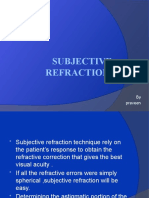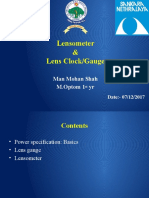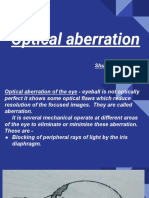Spherocylinder Lenses
Spherocylinder Lenses
Uploaded by
Eric DarmonoCopyright:
Available Formats
Spherocylinder Lenses
Spherocylinder Lenses
Uploaded by
Eric DarmonoCopyright
Available Formats
Share this document
Did you find this document useful?
Is this content inappropriate?
Copyright:
Available Formats
Spherocylinder Lenses
Spherocylinder Lenses
Uploaded by
Eric DarmonoCopyright:
Available Formats
spherocylinder lenses, page 1 W. F.
Long, 1992
S
S
P
P
H
H
E
E
R
R
O
O
C
C
Y
Y
L
L
I
I
N
N
D
D
E
E
R
R
L
L
E
E
N
N
S
S
E
E
S
S
Cylinder Lenses
A cylinder lens is cut from the surface of a cylinder. Cylinder lenses can
be concave or convex, as shown below.
For the lenses shown, the horizontal meridian looks like a cross-section
of a spherical lens and the vertical meridian looks like a plane wedge. The
focusing of light in these meridians can be handled by the usual simple
paraxial equations. To fully characterize a cylinder lens, not only the
power of the cylinder F but also the angle of orientation of its axis (90
in the figures above) must be specified.
Example: A convex crown glass hemi-cylinder of 5cm radius of
curvature, negligible thickness, and vertical axis refracts
light from a point 20cm away. What happens?
Solution: Find the power in each meridian of the cylindrical lens.
Horizontal meridian: The plane back surface has zero power so
the power in the horizontal meridian is
F
H
=(1.523-1)/0.05=+10.5D.
spherocylinder lenses, page 2 W. F. Long, 1992
Vertical meridian: Both surfaces are plane so there is zero
power in the vertical meridian.
The vergence of light reaching the lens is L=1/(-0.02)=-5.0D.
So in the horizontal meridian the exiting vergence is
L
H
'=F
H
+L=+10.5-5.0=+5.5D
l
H
'=1/L
H
'=1/+5.5D=+18.3cm.
In the vertical meridian which has no power, l
V
'=-20cm.
Seen in perspective, here is what would happen in the two
meridians.
As can be seen, a focal line is formed 18cm behind the lens.
But what goes on in the oblique meridians? These oblique meridans are
not spherical and have no real power. In a certain sense, however, they
have a fictitious power F
=Fsin
2
where F is the cylinder power and the
angle between the meridian in question and the cylinder axis.
focal line
B
spherocylinder lenses, page 3 W. F. Long, 1992
Spherocylindrical Surfaces
Spherical surfaces have the same curvature in all meridians. Cylindrical
surfaces are flat in one meridian and have maximum curvature in another,
perpendicular, meridian. But lots of surfaces are curved in all meridians
with different curvatures in all meridians, for example, donuts and
watermelons. The simplest such surfaces are toric surfaces and toric
surfaces are what's used in ophthalmic lenses. Astigmatism can be
corrected with cylinder lenses. In practice it is corrected with lenses
which have toric surfaces.
A toric surface is generated mathematically by rotating a circular arc
around an axis that does not go through the center of the circle. (If we
rotated it around the center of the circle we'd just get a sphere.) This
generates surfaces in barrel form or tire form (donut form) as shown
above.
A spherocylinder lens is usually made by grinding a spherical surface on
one lens surface (the front surface for most spectacle lenses) and a toric
surface for the other lens surface (the back surface for most spectacle
lenses).
barrel form tire form
spherocylinder lenses, page 4 W. F. Long, 1992
The diagram above shows a circular converging lens with a toric front
surface bending light from a point source, B. As can be seen, the lens
forms two perpendicular line foci with a blur circle in between. A
receiving screen placed at any of these positions will show a line or a
circle. At any other position, an ellipse will appear on the screen. Finding
the positions of the line foci and circle of confusion is an interesting
problem. It is solved by redrawing the horizontal and vertical line pencils
in the plane of this page.
B
focal lines
blur circle
spherocylinder lenses, page 5 W. F. Long, 1992
The positions of the two line foci can be calculated from the fundamental
paraxial equation. By applying straightforward, but tedious, geometry to
the figure above, it may be shown that the vergence of light forming the
blur circle is the average of the vergences of light forming horizontal and
vertical line foci, or in equation form,
1/l
C
'=L
C
'=(L
V
'+L
H
')/2=(1/l
V
'+1/l
H
')/2.
The linear interval between the two line foci, incidentally, is called the
interval of Sturm. The half widths of the vertical and horizontal line foci,
w
V
and w
H
, and the radius of the circle of least confusion, w
C
, are
w
V
=p(1-L
V
'/L
H
'),
w
H
=p(L
H
'/L
V
'-1),
w
C
=p[(L
H
'-L
V
')/(L
H
'+L
V
')].
B
vertical line
focus
horizontal line
f ocus
circle of least
confusion
l l '
H
l '
C
p
w
V
w
H
w
C
l '
V
lens
spherocylinder lenses, page 6 W. F. Long, 1992
Example: Find the positions of the line foci and blur circle and the
interval of Sturm for a toric lens with +5.00D in the horizontal
meridian and +8.00D in the vertical meridian when imaging a
point object one meter in front of the lens.
Solution: The incoming vergence is L=1/(-1m)=-1.00D. The outgoing
vergence in the horizontal meridian is +5.00D-1.00D=+4.00D.
This corresponds to a distance of 1/(+4)=+25cm, where the
vertical line focus is formed. In the vertical meridian,
outgoing vergence is +8.00D-1.00D=+7.00D. This corresponds
to a distance of 1/(+7.00)=+14.3cm, where the horizontal line
focus is formed. The interval of Sturm is just
25cm-14.3cm=10.7cm. The vergence going to the blur circle is
(+4+7)/2=+5.5D so the blur circle is 1/(+5.5D)=+18.2cm behind
the lens.
Astigmatic Imagery
An astigmatic system produces "smeared images", the amount and
direction of the smear depending on the position of the receiving plane. At
the horizontal line focus, for example, images will be smeared left to
right while at the vertical line focus they will be smeared up and down.
The "best" focus is usually taken to be in the plane of the circle of least
confusion in which there is at least equal blurring in all directions. The
"best" focus, however, might depend on the task and target. It is likely
that patients with astigmatic eyes are constantly adjusting their focus
along the interval of Sturm. That may account for the eyestrain of
asti gmats.
Ophthalmic Lenses
Spectacle lenses consist of one spherical surface and one toric surface.
Prescri pti ons for spectacl e l enses are, however, wri tten as a
superposition of spherical and cylindrical lenses. There are three ways to
write a spectacle prescription; plus cylinder form (favored by M.D.'s),
minus cylinder form (favored by optometrists), and cross cylinder form
(used, sometimes, in fabrication labs). It's easiest to understand these
forms and their relationship by reference to a power cross like the one
below.
spherocylinder lenses, page 7 W. F. Long, 1992
This cross represents a lens surface as viewed from the doctor's point of
view, i.e. looking straight at the patient. The lens has two principal
meridians (meridians of circular cross-section), with powers F
1
and F
2
.
Their orientations are shown on the diagram.
We could specify the prescription for the lens in the diagram by writing
F
1
@/F
2
@( 90).
( 1)
That is how keratometric findings (measurements of corneal curvature)
are typically written, but lens powers are never written in this form.
Recall that for a pure cylinder lens of power F
C
and axis the prescription
can be written as F
C
x or F
C
@(90).
F
F
2
1
+90
spherocylinder lenses, page 8 W. F. Long, 1992
We can think of the lens in the diagram as a superposition of two cylinder
lenses and write (1) as
F
S
x /(F
S
+F
C
)x(90).
( 2)
Equation (2) is the cross cylinder form. In diagram terms it sets up like
below:
F
1
x(90) F
2
x.
Since you can add sphero-cylinder lenses meridian by meridian, as long as
the principal meridians are the same, you can see that this form gives the
correct prescription.
F
2
F
1
0.0
0.0
+
+90
+90
spherocylinder lenses, page 9 W. F. Long, 1992
Another, more common way of writing the prescription is in sphero-
cylinder form in which the prescription is represented as a spherical lens
of power F
S
superimposed on a cylinder lens with power and axis F
C
x.
This is written in the form
F
S
/ F
C
x.
( 3)
In diagrams, equation (3) is represented as
F
S
F
C
x
The cylinder power can be positive or negative. The sign of the cylinder
determines whether the prescription is in plus or minus cylinder form.
Now the problem is how to relate the sphero-cylinder form (3) to the
crossed cylinder form (2). The key to doing this is in the diagrams.
Clearly, by equating powers in corresponding meridians, F
1
=F
S+
F
C
and
F
2
=F
S
. The cross cylinder form corresponding to the sphero-cylinder form
is thus,
(F
S
+F
C
)x/F
S
x(90).
( 4)
F
C
F
S
+
F
S
+90
+90
0.0
spherocylinder lenses, page 10 W. F. Long, 1992
A given spectacle prescription can be written in any of these forms. The
problem is converting among them. Here are three equivalent forms of a
prescription.
F
S
/F
C
x
(F
S
+F
C
)/(-F
C
)x(90)
(F
S
+F
C
)x/F
S
x(90).
( 5)
If F
C
>0, these are, respectively, the plus cylinder, minus cylinder, and
cross cylinder forms. Note that 90is taken such that
18090>0. In cross cylinder form it is customary to write the meridian
for the smaller angle first.
Let's try it with some numerical examples. In each case there are three
equivalent forms of the same prescription:
+3.00-1.00x030
+2.00+1.00x120
+2. 00x030/ +3. 00x120
-1.50-2.50x100
-4.00+2.50x010
-1. 50x010/ -2. 50x100
+1.00-4.25x025
-3.25+4.25x115
-3. 25x025/ +1. 00x115
pl ano/+0.50x180
+0.50-0.50x090
0. 00x090/ +0. 50x180
You might also like
- Symmetry (Planes Of)Document37 pagesSymmetry (Planes Of)Aminath Simha100% (1)
- CPG 19Document78 pagesCPG 19anon-24970100% (1)
- OptoPrep Part1 StudyCalendar 6-Month PDFDocument7 pagesOptoPrep Part1 StudyCalendar 6-Month PDFmelanieNo ratings yet
- 03 Schematic EyesDocument10 pages03 Schematic EyesMwanja Moses100% (1)
- Clinical Orthoptics - Fiona Rowe - 146Document6 pagesClinical Orthoptics - Fiona Rowe - 146Danielle SangalangNo ratings yet
- Topic 15 (1) - Spectacle Lenses and Their Subsidiary EffectsDocument11 pagesTopic 15 (1) - Spectacle Lenses and Their Subsidiary EffectsshadowosNo ratings yet
- Myopia ManualDocument337 pagesMyopia ManualRealPurgatory100% (1)
- Eyes On Eyecare - 2021 - Dry Eye ReportDocument28 pagesEyes On Eyecare - 2021 - Dry Eye ReportEsther AlonsoNo ratings yet
- OculomotorDocument41 pagesOculomotorcmirceaNo ratings yet
- Subjective Refraction: by PraveenDocument61 pagesSubjective Refraction: by PraveenHenok Biruk100% (1)
- Lensometer & Lens Clock/Gauge: Man Mohan Shah M.Optom 1 YrDocument53 pagesLensometer & Lens Clock/Gauge: Man Mohan Shah M.Optom 1 YrManmohan Shah100% (1)
- KERATOMETRYDocument3 pagesKERATOMETRYMarjune DimayugaNo ratings yet
- 01-06 Astigmatic LensesDocument16 pages01-06 Astigmatic LensesVadim PopoviciNo ratings yet
- BifocalsDocument18 pagesBifocalsMatthew Murphy100% (1)
- Introduction To Spherical Lenses2Document6 pagesIntroduction To Spherical Lenses2Nuon HudaNo ratings yet
- Anomalie VisionDocument13 pagesAnomalie Visionblueice100% (1)
- Low Vision PrinciplesDocument272 pagesLow Vision Principlesmariam mhNo ratings yet
- Night MiopiaDocument8 pagesNight MiopiamurilobsouzaNo ratings yet
- ITP2Document42 pagesITP2Mehak JainNo ratings yet
- Ophthalmic Prism: Man Mohan Shah M.Optom (1 Yr)Document40 pagesOphthalmic Prism: Man Mohan Shah M.Optom (1 Yr)Manmohan ShahNo ratings yet
- Ophthalmic Lens DesignDocument22 pagesOphthalmic Lens DesignBernardo Leñero100% (1)
- Bifocal & Multifocal: Capt. Dr. Deependra Kumar Sah M.Optom (Bharati Vidyapeeth, Pune) B.Optom (TUTH, IOM)Document66 pagesBifocal & Multifocal: Capt. Dr. Deependra Kumar Sah M.Optom (Bharati Vidyapeeth, Pune) B.Optom (TUTH, IOM)Paudyal IViratNo ratings yet
- Optics - Contact Lens Related - MMSDocument38 pagesOptics - Contact Lens Related - MMSManmohan ShahNo ratings yet
- Contact Lens GuideDocument8 pagesContact Lens Guideapi-3791891No ratings yet
- Optical AberrationDocument20 pagesOptical AberrationShubhangi ShuklaNo ratings yet
- DR Paul Krawitz - Ultimate Insiders Guide To Eye HealthDocument60 pagesDR Paul Krawitz - Ultimate Insiders Guide To Eye HealthPro A100% (1)
- Understanding Corneal Topography Final 1Document42 pagesUnderstanding Corneal Topography Final 1OmariNo ratings yet
- Optics and Refraction For PodcastDocument75 pagesOptics and Refraction For Podcastapi-213285088No ratings yet
- Subjective RefractionDocument21 pagesSubjective RefractionSafeet Shahbaz100% (1)
- How To Use A FocimeterDocument13 pagesHow To Use A FocimeterAriyanie Nurtania100% (1)
- 05 Lens Types Multifocals PDFDocument10 pages05 Lens Types Multifocals PDFHasan AnsariNo ratings yet
- RGP Fitting ReviewDocument4 pagesRGP Fitting ReviewSulki HanNo ratings yet
- Frame SelectionDocument21 pagesFrame Selectionhenok birukNo ratings yet
- Corneal Topography and TomographyDocument18 pagesCorneal Topography and TomographyPande GustianaNo ratings yet
- RefraksiDocument84 pagesRefraksinaroetocapkutilNo ratings yet
- Ophthalmic PrismDocument55 pagesOphthalmic PrismHimank Rana100% (1)
- 09 EmmetropizationDocument18 pages09 EmmetropizationMwanja MosesNo ratings yet
- Syl Optometry ReadDocument1 pageSyl Optometry ReadlaksmanaNo ratings yet
- Iol Power Calculation Warren HillDocument4 pagesIol Power Calculation Warren HillMariana Luzardo bravoNo ratings yet
- PERIMETRY Introduction GuideDocument70 pagesPERIMETRY Introduction GuideDana Andreea Popescu100% (1)
- Method of Extending The Range of The KeratometerDocument3 pagesMethod of Extending The Range of The KeratometerDanielle SangalangNo ratings yet
- 25 Dispensing PALs PDFDocument14 pages25 Dispensing PALs PDFVaishali SinghNo ratings yet
- 05 Thin Lenses 2Document18 pages05 Thin Lenses 2HelenNo ratings yet
- Slit LampDocument2 pagesSlit LampAriNo ratings yet
- Basic AberrometryDocument54 pagesBasic Aberrometrysightbd100% (2)
- Aspheric Lenses - Optometry TodayDocument4 pagesAspheric Lenses - Optometry TodaySourav KarmakarNo ratings yet
- Anatomy of Uvea: Dr. Binu AsharafDocument48 pagesAnatomy of Uvea: Dr. Binu AsharafBinu AshrafNo ratings yet
- Subjective Refraction TechniquesDocument14 pagesSubjective Refraction TechniquesWeronika Politowska100% (1)
- Refractive Errors: Dr. Kemal DikiciDocument77 pagesRefractive Errors: Dr. Kemal DikiciFirman CappoNo ratings yet
- Scleral FittingDocument36 pagesScleral FittingDorjan BogojevicNo ratings yet
- General Formula For Bi-Aspheric Singlet Lens Design Free of Spherical AberrationDocument5 pagesGeneral Formula For Bi-Aspheric Singlet Lens Design Free of Spherical AberrationSç-č AbabiiNo ratings yet
- SR Inter Ipe Question Bank Chapter-II (Ray Optics and Optical Instruments)Document18 pagesSR Inter Ipe Question Bank Chapter-II (Ray Optics and Optical Instruments)sojakoj867No ratings yet
- RGP Lens MeasurementDocument5 pagesRGP Lens MeasurementSumon SarkarNo ratings yet
- UveaDocument83 pagesUveaShewit TeklehaymanotNo ratings yet
- The Slit Lamp ExamDocument30 pagesThe Slit Lamp Examrapid73No ratings yet
- Slit LampDocument23 pagesSlit LampShubhangi ShuklaNo ratings yet
- Clinical Assessment GuideDocument2 pagesClinical Assessment GuideSim Pei YeeNo ratings yet
- Our Eye As A Camera Refraction, Errors and Solutions.: DR - Ali.A.Taqi Fifth Year StudentsDocument44 pagesOur Eye As A Camera Refraction, Errors and Solutions.: DR - Ali.A.Taqi Fifth Year Studentsabigail100% (1)
- Strabismus - A Decision Making Approach (G Noorden)Document197 pagesStrabismus - A Decision Making Approach (G Noorden)Raluca OpreaNo ratings yet
- 2010 Clinical Guide To Ophthalmic DrugsDocument52 pages2010 Clinical Guide To Ophthalmic DrugsJonathan PenmNo ratings yet
- AI Recommendation SystemDocument20 pagesAI Recommendation SystemChitra ParsailaNo ratings yet
- System EngineeringDocument19 pagesSystem EngineeringJayashree100% (1)
- CHAPTER 4: Antenna Array and SynthesisDocument15 pagesCHAPTER 4: Antenna Array and SynthesisTibebu Xibe TeNo ratings yet
- Receiver Function TutorialDocument6 pagesReceiver Function TutorialDeka Agung PratamaNo ratings yet
- Bright 2015Document14 pagesBright 2015Itzee Qast GarxNo ratings yet
- Pradip Patel Kunal ShahDocument15 pagesPradip Patel Kunal ShahPradeep PatelNo ratings yet
- Business Decision Making Course OutlineDocument3 pagesBusiness Decision Making Course OutlineShekhar SinghNo ratings yet
- Equilibrium of Concurrent Forces in A PlaneDocument13 pagesEquilibrium of Concurrent Forces in A Planewajju007No ratings yet
- AC Resume (English - March 2017)Document2 pagesAC Resume (English - March 2017)Angelo CaraballoNo ratings yet
- Shallow Foundations: Ultimate Bearing CapacityDocument18 pagesShallow Foundations: Ultimate Bearing CapacityAlaa TelfahNo ratings yet
- Automation FMSDocument164 pagesAutomation FMSSudhakar FormworkNo ratings yet
- Sit 212 Lecture NoteDocument99 pagesSit 212 Lecture NoteTracy JaneNo ratings yet
- Interval Estimates: Ed Neil O. Maratas Bs Statistics, Ma MathematicsDocument10 pagesInterval Estimates: Ed Neil O. Maratas Bs Statistics, Ma Mathematicsedniel maratasNo ratings yet
- Stability PDFDocument64 pagesStability PDFGlan DevadhasNo ratings yet
- Lesson 3-8 Solve Systems of Equations Algebraically (Homework Practice)Document4 pagesLesson 3-8 Solve Systems of Equations Algebraically (Homework Practice)nonNo ratings yet
- Basic Future Forms: Will/ LLDocument3 pagesBasic Future Forms: Will/ LLmartin alexander acosta galvanNo ratings yet
- Chapter 1 Concepts of Motion: Physics For Scientists and Engineers, 4e (Knight)Document11 pagesChapter 1 Concepts of Motion: Physics For Scientists and Engineers, 4e (Knight)Ting YuNo ratings yet
- Salesforce Field Names ReferenceDocument61 pagesSalesforce Field Names ReferenceVishwanath MalayathiNo ratings yet
- Is.13630.1-5.2006 CERAMIC TILESDocument50 pagesIs.13630.1-5.2006 CERAMIC TILESBattula SridharNo ratings yet
- Mechanics WorksheetDocument64 pagesMechanics WorksheetyeosiewliNo ratings yet
- Sobolev Gradients and Di Erential Equations: Author AddressDocument154 pagesSobolev Gradients and Di Erential Equations: Author AddresscocoaramirezNo ratings yet
- DS LAB ManualDocument105 pagesDS LAB Manualapparisanjay403No ratings yet
- India's Petroleum Demand: Empirical Estimations and Projections For The FutureDocument30 pagesIndia's Petroleum Demand: Empirical Estimations and Projections For The FutureSantosh creationsNo ratings yet
- (More Than One Answer Is Correct) : TAW10 2/2 ABAP Workbench FundamentalsDocument24 pages(More Than One Answer Is Correct) : TAW10 2/2 ABAP Workbench FundamentalsAdriana Matute MartinezNo ratings yet
- P2 Sept2012 QuestionpaperDocument16 pagesP2 Sept2012 QuestionpaperjoelvalentinorNo ratings yet
- 3 - Principles of Data ReductionDocument14 pages3 - Principles of Data Reductionlucy heartfiliaNo ratings yet
- Data Structures Algorithms Mock TestDocument6 pagesData Structures Algorithms Mock Testnehal nasimNo ratings yet
- Lecture Slide On Inductance of Three-Phase LineDocument7 pagesLecture Slide On Inductance of Three-Phase LineSifat -Ul-AlamNo ratings yet
- DLP-Maths Made Easy Year 4 KSSRDocument101 pagesDLP-Maths Made Easy Year 4 KSSRClara DooNo ratings yet

























































































